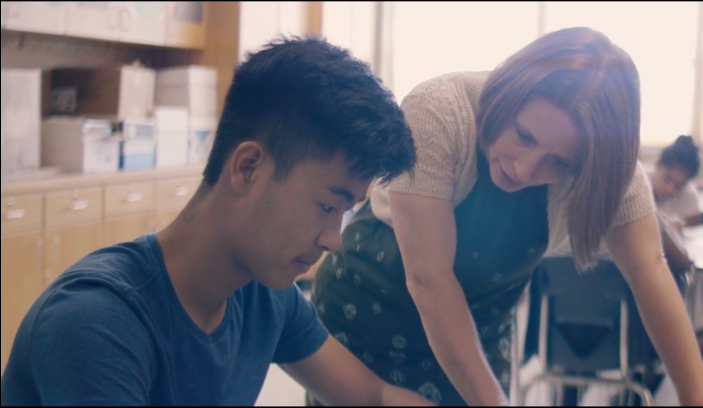Coming to America from Andrew Q Holzschuh on Vimeo.
Meet Than Zaw Oo, the Burmese refugee and talented artist from our story on suburban students at Dallas ISD magnet schools. The video shows what a hard-working, determined young man he is, and also the incredible value of people and nonprofits, like the Vickery Meadow Youth Development Foundation, to give students like him the boost they need and deserve.
Zaw Oo, as you remember from the story, was denied a spot at Booker T. Washington High School for the Performing and Visual Arts the same year that 89 students from outside of Dallas ISD attended the school.
We don’t know exactly how he fared in the audition process. We don’t know if the absence of suburban students would have opened a spot for him. But judging from the video, it’s safe to say that Zaw Oo is the kind of model student who should be given every opportunity the school district can provide.

Janet Morrison-Lane, director of the Eagle Scholars program at the Vickery Meadow Youth Development Foundation, works with Burmese refugee Than Zaw Oo.
Zaw Oo is one of the foundation’s “eagle scholars,” and Janet Morrison-Lane, the director of the scholars, pushes her students to their limits as she advocates for them. Her frustrations with trying to navigate the maze of magnet school applications were voiced in a Dallas Morning News column this past spring.
In it, she told the story of Rooha, a talented musician from Iran who did get accepted to Booker T. but dropped out three days into the school year.
“[Rooha] was overwhelmed her first day of classes: ‘No one else looks like me and all of the students have more experience than I do.’
Later that day, she received a text stating, ‘Your first field trip payment of $100 is due on Friday. You may pay in cash or check.’
Rooha discovered she was one of only two students in her orchestra class who didn’t receive private lessons. She was told, ‘The only way for you to keep up with the music is to take private lessons,’ with an empathetic, ‘I can give you names of cheaper teachers that only cost $35 an hour.’
While Rooha’s parents had taken her to school that day, she learned her closest bus stop was Hillcrest High School, nearly three miles from her home school, Conrad High School. Rooha’s parents can’t take her to school everyday, or to Hillcrest. Understanding her family’s financial struggles, Rooha did not want to ask them to accommodate her with transportation, private lessons and field trip money.
It was all too much.”
Morrison-Lane admits that she gets frustrated with her students, too, when they don’t push themselves out of their comfort zones.
“She’s at the top of her class, and when she got to Booker T., she was at the bottom,” Morrison-Lane says of Rooha. “She’s never had to feel stupid. The kids get in and they don’t think they’re worth it. She didn’t think she could hang.”
Students like Than Zaw Oo and Rooha are what the district might label “students of promise.” They are smart, talented, capable and hard-working, but they lack the middle- and upper-class resources that help propel so many students to the highly competitive magnet schools and support them once they are there.
Back in 2010, when the board first revised the magnet school policy to give preference to students’ younger siblings and to give in-district students first dibs on magnet school slots, trustees also considered a policy that would reserve 10 percent of seats for “students of promise.”
North Dallas Trustee Edwin Flores, who was outspoken against suburban students attending DISD schools in our story, supported this policy when it was proposed. “As a general idea, I think it’s a good idea,” he said in a September 2010 Dallas Morning News story, adding that “it’s a way to help students who are on the upswing.”
Two other trustees who, like Flores, still sit on the board, felt differently.
“If a student gets into a magnet school, and they can’t cut it, they’re set up for failure, and that student is frustrated,” said southern Dallas Trustee Bernadette Nutall in a follow-up DMN story. Trustee Lew Blackburn, who also represents southern Dallas, said he “wasn’t comfortable with the idea of turning away qualifying students and reserving spots for lesser qualified students. He likened it to an ‘affirmative action’ plan and, hypothetically speaking, said he would have a problem if his qualified granddaughter was turned away.”
This echoed a similar proposal floated in 1989 when trustees were trying to figure out how to funnel more minority students to Booker T., which was 60 percent white despite its goals of diversity. The idea, according to an October 1989 DMN story, was to “broaden admissions standards to accept some students with ‘raw talent or potential for experiencing success’ ” because, some board members said, the audition process “may discriminate against minorities.”
But this would hurt the award-winning school, parents and students argued to the board.
“There is no way you can change or modify or alter auditions and still maintain the talent level,” one student said.
The rallying cries of “don’t hurt a successful school” and “don’t set students up for failure” won the day in both cases and continue to define Dallas’ magnet schools.
Consider Rooha. She was among the best and brightest at her middle school and felt like a fish out of water at Booker T. If students who actually make the cut of elite magnet schools feel lost, wouldn’t it be worse for “students of promise” who don’t?
But perhaps that’s the wrong question. Morrison-Lane asks a different one at the end of her column:
“If 89 percent of DISD students qualify for free- and reduced-price lunch, shouldn’t we examine policies that require struggling parents to drive, take off work and pay for services if they want their children to access the best education DISD offers?”





